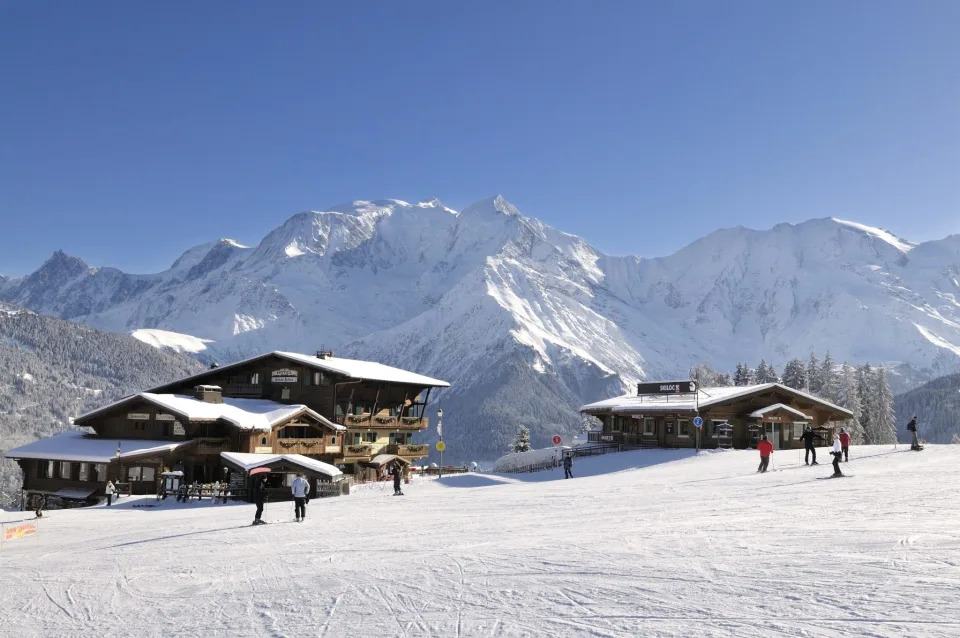I THOUGHT THEY WENT TO NZ
Ryan Hogg
Tue, November 7, 2023

JARRY TRIPELON—Gamma-Rapho via Getty Images
The rich are jumping on their climate crisis lifeboats and moving in their droves to the wintry climes of the Alps. But an exodus north might not spell a happy ending for the ultra-wealthy.
A study of the ski property sector by real estate agency Knight Frank showed the Alpine region—where winter temperatures typically move into the low 20 degrees Fahrenheit—was enjoying renewed interest from wealthy buyers.
Prices across 24 resorts in Switzerland and France rose 4.4% on average last year, with a couple of destinations in Switzerland enjoying double-digit price increases.
Rising demand now appears to be driven by nervous customers from sunnier regions looking for a chalet as a second home further from the equator.
“There are clear challenges ahead for ski resorts, not least climate change, the need to upgrade infrastructure, and strict planning rules,” said Kate Everett-Allen, Knight Frank’s head of global residential research.
“But the market is evolving, attracting buyers from further afield (Asia and Middle East) and from southern Europe, as recent heatwaves prompt some second homeowners to pivot northwards.”
Ryan Hogg
Tue, November 7, 2023

JARRY TRIPELON—Gamma-Rapho via Getty Images
The rich are jumping on their climate crisis lifeboats and moving in their droves to the wintry climes of the Alps. But an exodus north might not spell a happy ending for the ultra-wealthy.
A study of the ski property sector by real estate agency Knight Frank showed the Alpine region—where winter temperatures typically move into the low 20 degrees Fahrenheit—was enjoying renewed interest from wealthy buyers.
Prices across 24 resorts in Switzerland and France rose 4.4% on average last year, with a couple of destinations in Switzerland enjoying double-digit price increases.
Rising demand now appears to be driven by nervous customers from sunnier regions looking for a chalet as a second home further from the equator.
“There are clear challenges ahead for ski resorts, not least climate change, the need to upgrade infrastructure, and strict planning rules,” said Kate Everett-Allen, Knight Frank’s head of global residential research.
“But the market is evolving, attracting buyers from further afield (Asia and Middle East) and from southern Europe, as recent heatwaves prompt some second homeowners to pivot northwards.”
Pandemic surge
The wealthy flocked to buy second homes in ski resorts during the pandemic, propped up by historically low interest rates and a booming stock market.
And while the pandemic’s effect on buying is now diminishing in the face of rising interest rates, it’s clearly still affecting customers’ behavior.
Three-quarters of people surveyed by Knight Frank said they were working remotely more since the pandemic, with more than half now considering working from the Alps for longer periods to take advantage of their newfound flexibility.
However, it is now the longer-term threat of climate change that appears to be influencing buying habits, as rich clients seek refuge in the Alps. Southern Europe was gripped by a scorching summer of heat waves, which appears to have reminded buyers of the comforts of the cold.
There is perhaps some irony in the climate crisis fueling housing demand from the ultra-wealthy. Several studies have found the richer someone is, the more they will pollute on average.
Research from Oxfam published last year found the investments of 125 billionaires emitted C02 emissions equivalent to the whole of France. A study by the International Energy Agency (IEA) showed the top 10% of global emitters by income produced almost half of global energy-related CO2 emissions in 2021.
Alps not exempt from the climate crisis
The Alps have long been considered something of a “Goldilocks” zone for travelers. While the region can sit in freezing temperatures for around half the year, it offers some respite with warm summers that allow owners the chance to hike the same mountains they ski down in the winter.
However, moving to the Alps’ snowy peaks to escape the unpredictability of climate change is increasingly becoming a risky bet.
Ski seasons were once reliably five months long, spanning from early December to the end of April, and went even longer in certain parts of the Alps. Now, though, snowfall in lower-altitude regions is coming later most years and falling in a less consistent fashion.
Research published by the European Geosciences Union in 2017 found the Alps could lose between 30% and 70% of its snow coverage by the end of this century, hurting, among other things, wealthy owners’ investments.
Meanwhile, buyers hoping for a cooler summer with a trip to the Alps might also be left reaching for their hand fans and installing air conditioning. The region wasn’t exempt from Europe’s heat wave last summer — with the French ski resort of Alpe d’Huez hitting a record 85 degrees Fahrenheit in July.
The heat is causing the Alps’ breathtaking glaciers to melt at a record pace. An ecological crisis of vanishing species and rising water levels could follow.
Three out of five respondents to Knight Frank’s survey said they were concerned about the impacts of climate change on their resorts.
The agency said buyers are now split between purchasing homes at higher altitudes for a more reliable ski season, and those opting for locations with a more obvious split between winter and summer.
This story was originally featured on Fortune.com

No comments:
Post a Comment